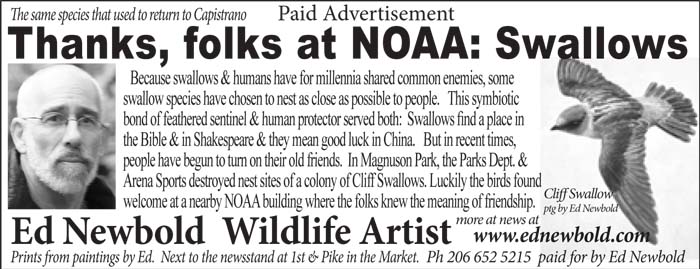
17 Jun Thank you to folks at NOAA in Magnuson Park
Posted June 17, 2013 from Seattle, WA
A tiny ad in the Seattle Times on Tuesday, June 18, 2013 will deliver a much-deserved thank you to folks at one of the NOAA buildings in Magnuson Park. The Cliff Swallow colony destroyed by the Seattle Parks Dept. on behalf of Arena Sports appears to be successfully relocating to the NOAA building, where they have been welcomed. Thank you, Thank you, Thank you, folks at NOAA.
The ad appears at a critical time in the history of Swallows (AKA Hirundines, from the Latin) in the Seattle area. This history will probably never be written, for lack of interest and lack of data, but my guess is that 2013 is perhaps the saddest downspike-year ever for the Seattle-based Barn Swallow population while the Violet-green Swallow population appears to have suffered a huge downspike in the 2012 breeding-year and merely continues on its glum path in 2013. With Cliff Swallows, which are historically a tiny minority of Seattle Swallows along with the other two, Tree and Rough-winged, there may be reason to be hopeful that there is no terrible downturn going on.
The demise of the bulk of Seattle’s Swallows follows on the heels of the decline of other air-foraging insect-eating birds here, the “Avian Aerial Insectivores.” (AAIs.) The Vaux’s Swifts seem to have bowed out earliest, I’m not sure when. A few may hang on in Seattle’s eastern slope or at Discovery Park or West Seattle, I don’t know. The Common Nighthawks were completely extirpated between 1975 and 1981, and it has always been my contention that the increasing Crow numbers at that time were the decisive factor in that. Other AAIs have also disappeared, such as the Bonaparte’s Gull and the Lewis’s Woodpecker. It has been suggested that for various reasons big and small that AAIs as a group are very especially at risk of decline and extinction in our brave new world.
Currently Cliff Swallows appear to holding on to their presence in Magnuson, a going colony seems in good shape at Union Bay, a smaller colony appears to be in existence at the Ship Canal, and individuals or a colony may be at the University Bridge. Further out-of-town Cliff Swallows exist on the lower Duwamish and at the Northwest corner of Mercer Island. Sadly, a colony at the UW Bothell campus has been the victim of the same style of persecution as occurred at Magnuson Park, except with no heros, like the NOAA people, emerging (Don’t take my word for this I have no up-to-date info on it, but I’m pessimistic.)
Let me make a point here. I fully understand that there are some places where Swallows are not going to be tolerated. Whether I agree with that or not is beside the point. On almost any building that houses Swallows, a carrot/stick approach could be used to lure the Swallows to a more appropriate place in the same buiding or nearby while netting is used to bar access to the places where their presence has been deemed unacceptable.

the green on the Violet-green Swallow. But I wondered about the violet. These birds are small and fast and it took this photograph by WA-state birding record holder Marv Breece to understand that that’s the only name this bird could h
Currently action by building managers all around Seattle appears to be 100% negative, which violates the spirit of the Migratory Bird Act as well our stewardship responsibilities to the Creation/Biodiversity. Cliff and Barn Swallows both build mud housing, and both normally need a small platform on which to build, preferably under an eave so that their work does not fall down suddenly in the wind and rain. Putting up small 2” x 3” ledges could give them good sites on, say, the side of a building or the back of a building if they are not wanted in the front, where netting would be put up.
In the case of Violet-green Swallows, which btw make no mess in the process of procreating, nestboxes could and should be placed in appropriate places on buildings to help this delightful bird in its struggle to survive in urban zone, where it thrived up until about the 1990s and still does hang on.
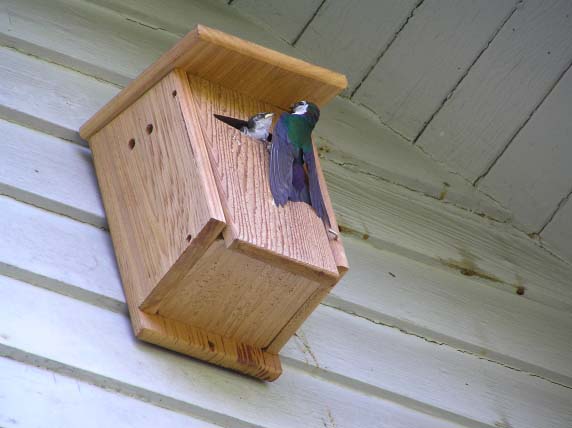
Lack of housing may be a big factor in the massive decline of Violet-green Swallows in urban Seattle. The house should be placed close up under eaves and the hole should not exceed 7/8 inch in height.
(Netting is also used in opposition to non-Hirundines such as House Sparrows, Eurasian Starlings and Rock Pigeons. It’s important to note that nesting platforms or Violet-green Swallow nest-boxes would not have the effect of inducing these birds to use the building.)
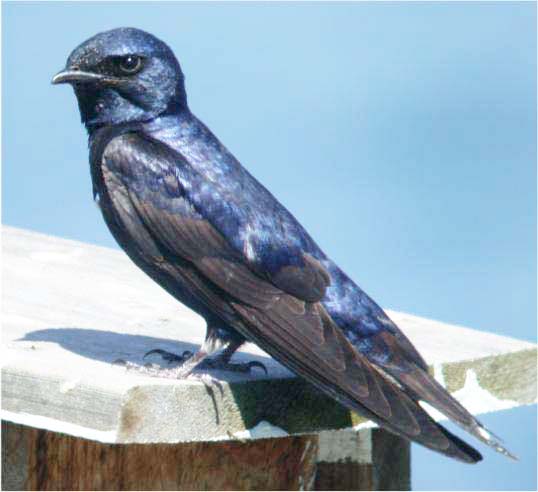
The late Kevin Li was a tireless helper of Purple Martins in Washington state. He took this shot of a male Martin sitting on one of his boxes along the Duwamish.
There are currently programs around the world designed to promote Green Buildings. These programs are largely feel-good programs at best and fraudulent at worst, as the Seattle-based writer Todd Myers has more or less proven.
Given the context of extinction I would add an additional charge that Myers does not level at the Green Building Codes and Programs: They completely ignore the issue of Swallow-friendliess/unfriendliness. It’s my contention that if a building is not Swallow-friendly, it should not be called “green.”
Why must we host the Hirundines in the first place?
For some, no reasons will be necessary. But others may not be on my side here and they well might say, “Wildlife belongs in the Wild!”
But ideas have consequences and the seemingly common-sense notion that “Wildlife belongs in the wild” actually incorporates a pernicious misunderstanding of the world that will help advance the evil march of extinction and destruction of nature. Let’s go back in time.
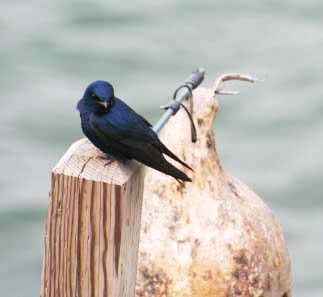
Kevin Li began his career helping Martins using wooden boxes but as he learned more about the birds he began to prefer gourds, the same as American Indians used to attract Martins.
Humans, wherever they settled, have always had an outsized influence on the ecology. If I may be forgiven for some caricaturizing, the way critters responded to people was to either “side with,” or take sides against humans. Wolves in Europe often tried the “against” approach. During World War I, Russian and German forces became unable to conduct warfare against each other because of Wolf-caused-depredations against their troops. They momentarily struck a truce and spent several weeks united in an all-out war against the Wolves, which they won, before going back to fighting each other.
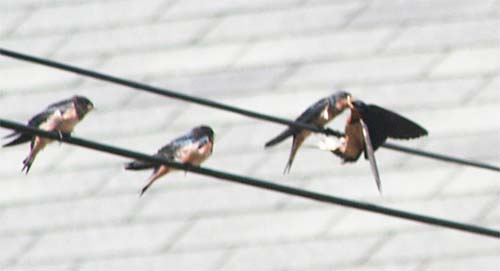
Swallows resemble their human hosts in that they must spend massive amounts of time and energy feeding and educating their young. Here a parent feeds a baby on fledging-day but the parents will continue to train and escort and protect the kids perhaps all the way to Argentina.
That’s extreme, but many a fruit-eating or grain-eating bird has paid the price for taking the “against people” side. Parrots are in extreme danger of extinction all over the world because they are predators of seeds, which puts them at odds with farmers.
But Swallows are among the most salient example of a group of animals that have “sided with” humans. Some Swallows, such as Bank Swallows and Rough-winged Swallows, don’t seem to have any particular relationship with people, but most of the others do to some degree or to the extreme. None exceeds the Barn Swallow. Last I read, no one had ever found a Barn Swallow nest in “the wild.” Barn Swallows are extremely high-anxiety birds that are the perfect sentinel, and probably their number one enemy has always been the Crow (or large Corvid), which is also usually the number one avian enemy of the farmer. Barn Swallows give the warning, people come out with artillery support, and the Human-Swallow team wins again.
Purple Martins are the biggest and most militarily-capable of the Swallows. American Indians induced the Martins to become colony-dwellers and to live above their maize fields. They did this by putting out gourds for them with entrance holes, and again the Swallow-human team worked to hold the Corvids at bay.
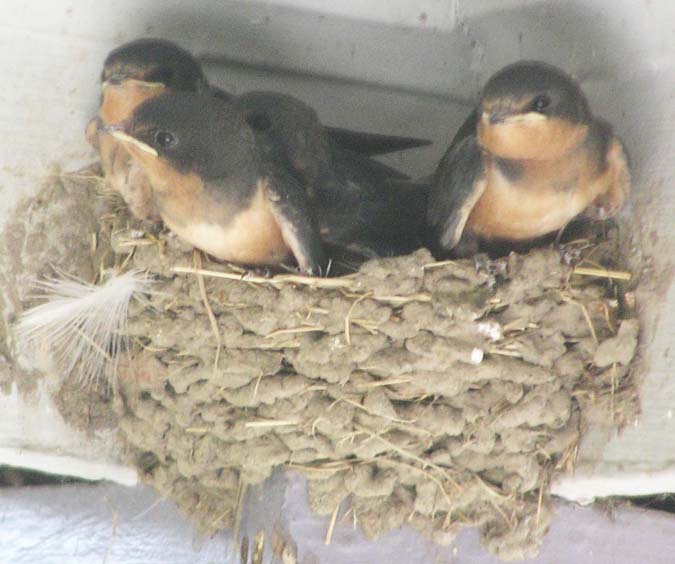
Barn Swallow babies wait for the next food drop from a parent. Both the father and mother are devoted to childcare.
But this relationship has been slowly unraveling throughout my (long) life-time. Swallows have attempted maintain the friendship, but people no longer care about Crows one way or the other, so Swallows no longer hold any Aces. As people become enamored of smart phones and don’t even listen to the sounds of nature when they run through the park with ear buds, they no longer even find Swallows to be a symbol of beauty and bright and cheerful sounds.
If you had a friend and every single thing you liked about them was zeroed out, you’d start focusing in what you didn’t like about them. OK, (some) Swallows are messy, but so are new-born babies. That’s no reason to backstab a millennium-long friendship.
It infuriates me especially that the two organizations that kicked the Magnuson swallows in the face were one that oversees our Parks and green spaces and another that gets to indoctrinate and propagandize the most socially-accomplished of our young kids, dispensing our taxpayer-given subsidy in the process.
When I moved to Seattle I got a place in the Cascade District, which had fairly recently been cut off from Capitol Hill by I-5. On the first nice spring day, in 1977, I took a walk up Lakeview and through North Capitol Hill and down Denny. I was astonished by the number of Barn Swallows and Violet-green Swallows that were nesting throughout the area, especially North Capitol Hill. Later that summer I began to realize that every neighborhood had nesting Nighthawks. A friend lived on the houseboats and he described summer evenings: Swallows hawking insects at water level, Swifts above them, Bonapartes Gulls hawking at a higher level in the sky and way up around 500 ft., Nighthawks hawking insects.
It’s inevitable that some of the most exuberant of natural phenomenon will disappear as more and more people live on Earth and I accept that. But it saddens that in the loss of one of the most beautiful sights on earth—swift long-winged birds lyrically swooping around catching flying bugs—we’re not even taking notes on the decline, that here in Seattle we’re just kicking them out the door.
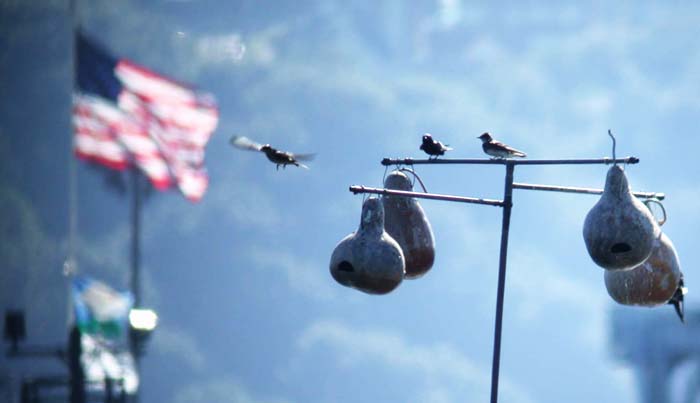
Purple Martins with gourds in Seattle. Gourd procurement and placement and photograph by the late, great Kevin Li

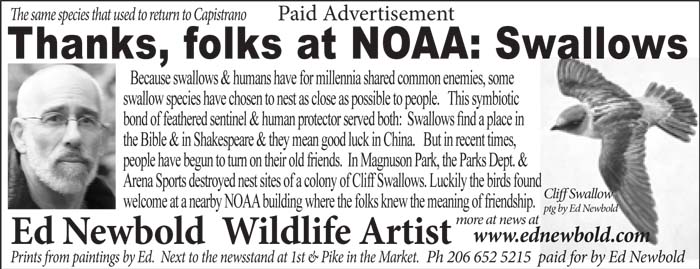
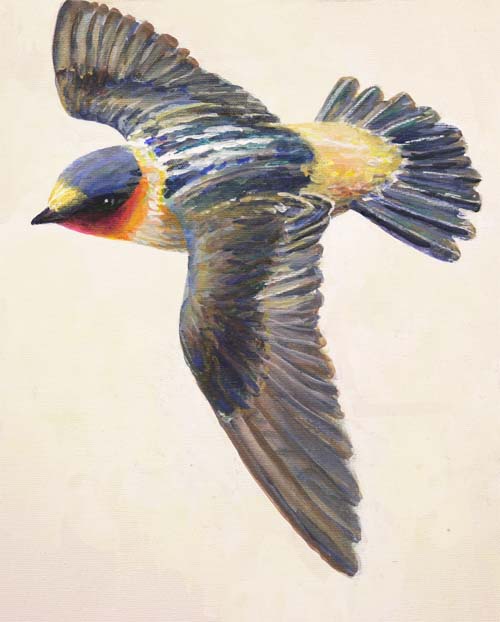
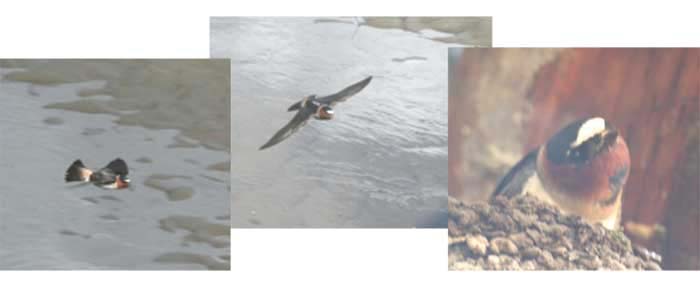
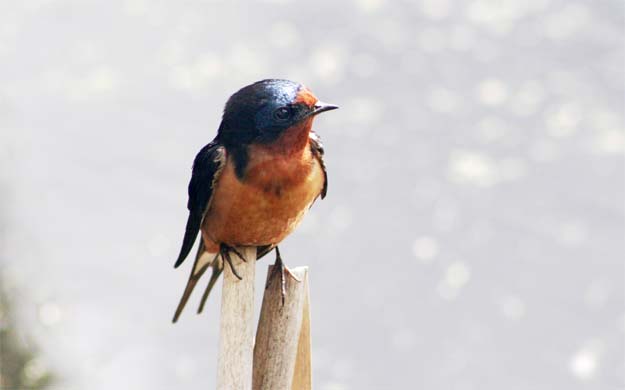
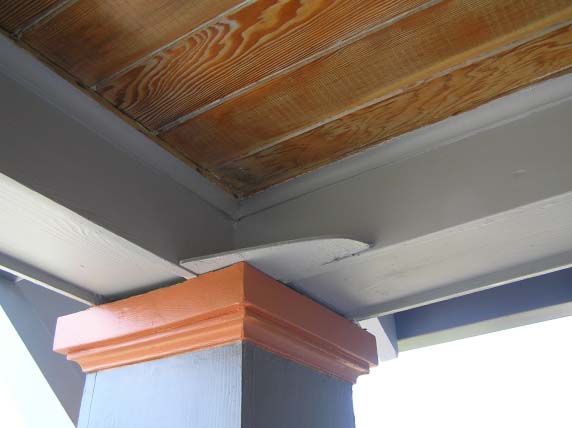
Herb Curl
Posted at 21:18h, 19 JuneThanks, Ed, for the beautiful photo essay. Everything you say is true. One of the reasons that the insect eating birds have disappeared here is that there are very few large flying insects. Why? Pesticides? With densification there are also fewer available nesting sites. Then we have the mysterious disappearances of Bonapart’s Gulls and Western Grebes.